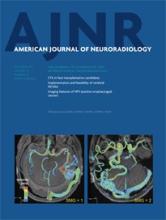Abstract
BACKGROUND AND PURPOSE: In patients with acute stroke, the location and extent of intravascular thrombi correlate with clinical and imaging outcomes and have been used to predict the success of intravenous thrombolysis. We hypothesized that 4D-CTA reconstructed from whole-brain CTP more closely outlines intracranial thrombi than conventional single-phase CTA.
MATERIALS AND METHODS: Sixty-seven patients with anterior circulation occlusion were retrospectively analyzed. For 4D-CTA, temporal maximum intensity projections were calculated that combine all 30 spiral scans of the CTP examination through temporal fusion. Thrombus extent was assessed by a semi-quantitative clot burden score (0–10; in which 0 = complete unilateral anterior circulation occlusion and 10 = patent vasculature). In patients with sufficient collateral flow, the length of the filling defect and corresponding hyperdense middle cerebral artery sign on NCCT were measured.
RESULTS: Clot burden on temporal maximum intensity projection (median clot burden score, 7.0; interquartile range, 5.1–8.0) was significantly lower than on single-phase CT angiography (median, 6.0; interquartile range, 4.5–7.0; P < .0001). The length of the hyperdense middle cerebral artery sign (14.30 ± 5.93 mm) showed excellent correlation with the filling defect in the middle cerebral artery on temporal maximum intensity projection (13.40 ± 6.40 mm); this filling defect was larger on single-phase CT angiography (18.08 ± 6.54 mm; P = .043).
CONCLUSIONS: As the result of an increased sensitivity for collateral flow, 4D-CTA temporal maximum intensity projection more closely outlines intracranial thrombi than conventional single-phase CT angiography. Our findings can be helpful when planning acute neurointervention. Further research is necessary to validate our data and assess the use of 4D-CTA in predicting response to different recanalization strategies.
ABBREVIATIONS:
- CBS
- clot burden score
- HMCAS
- hyperdense middle cerebral artery sign
- ICC
- intraclass correlation coefficient
- spCTA
- single-phase CT angiography
- tMIP
- temporal maximum intensity projection
- © 2013 by American Journal of Neuroradiology
Indicates open access to non-subscribers at www.ajnr.org












